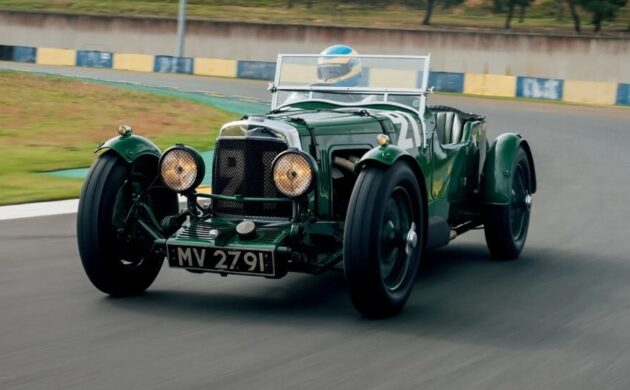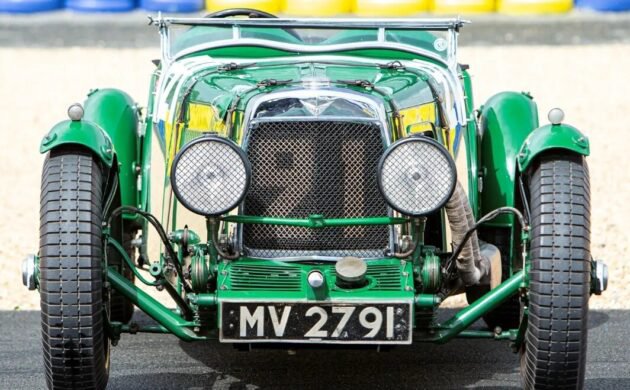One of Three: 1932 Aston Martin Le Mans ‘LM8’ Works Car
It is 1932, and Aston Martin – which had already rotated through a cast of owners and managers since its founding in 1913 – wants to go racing. Again. Augustus Bertelli, who was born in Italy but grew up in South Wales, is running the company. Bertelli believes that racing is the route to commercial success. His works team cars (called the LM series, for “Le Mans”) were built starting in 1928 and run at Le Mans that year, then in the UK in subsequent years. The next time Aston enters Le Mans, it is 1931, and LM6 manages a first in class and fifth overall. As the calendar turns to a new year, it takes only eight weeks for Bertelli to produce a redesigned LM, now known as the ‘second series’. Its low bonnet line, sharply V’d radiator, fold-flat windscreen, more powerful engine, and alloy bodywork are all aimed toward success at the track. The top now folds inside the body, and the front cycle fenders turn with the wheels. Three of these cars – LM8, 9, and 10 – are prepared by the factory for racing, but more than 100 are sold to privateers. Selling at RM Sotheby’s is Aston Martin chassis LM8, built in 1932, and raced at the famous track itself. The auction will be on June 9, 2023, at Le Mans, France, and the estimate is €950,000 – €1,350,000. We have Mitchell G. to thank for this spectacular tip!
By the time this car hit the tarmac, the four-cylinder motor displaced 1 1/2 liters. Improved porting in the cylinder head, a new intake manifold, four-branch header, a compression ratio of 7.5:1, and – for the race cars – twin 1 3/8″ SU carburetors helped raise output to at least 70 bhp. The transmission was a four-speed crash box encased in alloy. The three works cars were drilled for lightness and at every opportunity, lightweight components were crafted. Unfortunately, their first outing at Brooklands was unsuccessful, thanks to ill-conceived front springs. The cars were modified and run at Le Mans, where LM8 finished seventh overall. Aston’s poor finances forced the sale of all three works cars shortly thereafter, with LM8 leaving its race career fitted with a “two-four seater” body rather than its sparer competition form. Of course, Sotheby’s presents a veritable library of ownership for LM8, mentioning that the last owner had the engine, gearbox, and bodywork refreshed.
The car’s interior evokes the era and the car’s purpose. Coachwork was by Bertelli Ltd at Aston. The louvers were fancy – equipment to make these was scarce and expensive in the day. You can’t see it in this photo but these old gearboxes have a lever that acts as a reverse lockout. Fun!
Valuing scarce factory-prepared race cars is an art. Thanks to Glenmarch.com, we can find a single example that is remotely close to this car – LM5, which failed to find a buyer with a low estimate of €1,000,000 in 2019. A works car with heavy provenance was not enough to entice buyers to the seven-figure mark. While LM5 could be considered a lesser example from a technical perspective, belonging to the first series of LMs, it was substantially original. LM10 does appear to be for sale here but with no price listed. Any guesses at the final bid on LM8?
Auctions Ending Soon
 2002 Subaru Impreza WRXBid Now14 hours$333
2002 Subaru Impreza WRXBid Now14 hours$333
 1975 Chevrolet Corvette ConvertibleBid Now15 hours$4,000
1975 Chevrolet Corvette ConvertibleBid Now15 hours$4,000
 1964 Ford F-100 Camper CustomBid Now16 hours$2,000
1964 Ford F-100 Camper CustomBid Now16 hours$2,000
 2006 Jeep Wrangler SportBid Now2 days$11,000
2006 Jeep Wrangler SportBid Now2 days$11,000
 1974 Datsun 260ZBid Now4 days$750
1974 Datsun 260ZBid Now4 days$750





Comments
Once upon a time, I had the honor of helping with the rebuild of a ’33 Blower Bentley. I worked for a Rolls-Royce/ BMW dealer in New York.
I think this 1932 is really sharp!!
Even has doors that open. Quite civilized.
But hopefully only when you want them to!
Had the pleasure of a ride in a 1934 Aston Martin Lagonda tourer a fair few years ago. I believe it was a V12. It was a family legacy from the present owner’s father. He drove in the style of an ‘English Cad’; fast and furious. He luckily, had the steering wheel to hang onto in the corners. I simply gripped onto the bottom of my passenger seat. With those low cut doors, falling out was a real possibility. And it had two seats in the back for passengers! His younger sisters and their friends were scared out of their wits getting taken to school by their father in this same car.
What a rare and special machine. Great write-up, Michelle.
I love reading about these former track stars, especially from the 30’s and 40’s.
Not a guess as to what a niche racer like this would bring.